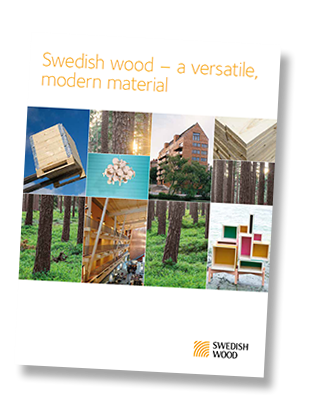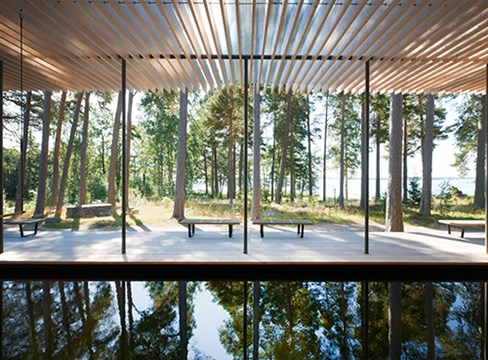What Swedish Wood does
Swedish Wood is specifically tasked with broadening the market for wood and increasing the value of wood products. It is backed by the Swedish sawmill industry, including manufacturers of glulam, CLT and wooden packaging, and suppliers to Swedish and European builders’ merchants and wholesalers.
International market balances are changing
The growth markets remain important in supplementing the traditional core markets in Europe. China plays a key role in Asia, with good growth in recent years. India, where work began in 2018, also has great potential. North Africa and the Middle East represent mature markets with varying potential and commercial risks. Construction is a priority in several of these markets, which improves export opportunities, albeit to an industry with a highly traditional structure that embodies small-scale craftsmanship. Our members’ international competitiveness and the development of logistical costs are crucial factors for success.
The challenge for Swedish Wood is to strengthen the position of the sawmills internationally, both in established markets in Europe and in growth markets.
Modern wood construction is increasing its market share
Urban construction offers potential for wood, particularly in Sweden and our core European markets.
The challenge for Swedish Wood is to expand modern wood construction, not least by disseminating knowledge, highlighting the environmental benefits and supporting the development of norms and building standards that favour wood.
Renovations, conversions and extensions a key market for wood
The housing stock in our traditional markets needs to be renovated and new generations want to adapt housing to their needs. Wood holds a strong position in these projects, but relevant product development is required.
The challenge for Swedish Wood is to strengthen the position of wood by sharing expertise on the right use of wood, as well as clarifying and developing the properties of wood products by stimulating product development and driving standardisation.
Wood, a natural material for interiors
Wood has historically been the dominant material for interior features such as flooring, internal cladding, mouldings, furniture, doors and windows. Interest in natural materials for interiors has seen a significant upturn recently, which offers wood opportunities to recapture market share, but not without product development and collaboration along the value chain as far as the end customer.
The challenge for Swedish Wood is to raise the status of Swedish softwood in interior design and joinery by developing and promoting top wood designs, and increasing knowledge of the material and how to work with it.
Packaging is a vital product area for wood consumption
Standardised packaging systems are central to modern distribution and wood holds a large share of the packaging market. However, wooden packaging is subject to tough competition from other materials, which creates a need for continued development of new products and services.
The challenge for Swedish Wood is to improve the market position of wooden packaging by promoting its benefits for the customer and for the climate.

We are developing our communication and spreading our messages
In 2018 we conducted a member survey to obtain a deeper understanding of how we can meet our member companies’ various needs. Based on the results, we have planned a series of measures and introduced a Member Satisfaction Index as a means to monitor future progress.
In order to develop our communication channels ,we work with key performance indicators that we monitor on a monthly basis. The website svenskttra.se has posted extremely good results and in 2018 it took first place in an industry comparison. Over the year, we expanded our content by introducing the wood packaging area, updating the image bank and adding a new map of members in both Swedish and English. 2019 will see us focus on developing our PR work and on further search engine optimisation of our websites.
We pass on knowledge about wood construction, both in Sweden and internationally
We hold talks and attend trade fairs, as well as delivering informative websites and publications. In November 2018, we organised a day of seminars on the topic of “Building in Engineered Wood”, which attracted 550 participants. We also appeared at the Nordic region’s biggest construction fair, Nordbygg in Stockholm, the wood fair Trä & Teknik in Gothenburg, which enjoyed a visit from H.M. The King of Sweden, and the housing fair Hem, Villa & Bostadsrätt in Stockholm, amongst others.
Many of the initiatives and projects conducted in the Swedish market can be adapted to other markets. Sweden saw the launch of the Glulam Handbook Part 4 while France gained the Glulam Handbook Parts 1–3. The CLT Handbook is set to be translated into English and Danish. A training package is also being developed for the Glulam Handbook Parts 1–4 and Design of Timber Structures Parts 1–3 in Sweden.
We reward good architecture in wood
2018 was to a large extent a planning year for the Swedish Wood Award 2020. The jury was announced in June and the competition opened in the autumn. By January this year, 130 entries had been submitted. In 2017, the Swedish Wood Award celebrated its 50th anniversary in Sweden with videos honouring projects and people in the industry. Similar campaigns will be rolled out in the UK, China and France in 2019. In 2018, Sweden was invited to be a joint organiser of the Prix International Architecture Bois and three Swedish structures in wood were nominated. Four issues of the magazine Trä were published, providing inspiring and interesting examples of great wooden architecture.
Swedish Wood drives modern construction
The Swedish Wood Building Council informs and lobbies. The domestic market is our biggest and it continues to grow thanks in part to the increasing interest in wood construction. Climate issues linked to construction dominate the political agenda at both local and national level. The proposal from Sweden’s National Board of Housing, Building and Planning (Boverket) for buildings to have declarations of climate performance is driving construction, planning and the market generally towards new approaches, with a strong focus on wood.
The Swedish market is experiencing a growing interest in wood construction, not least due to more than 20 years of promotional work. In 2018 the bottleneck was the wood construction industry itself, since the ongoing expansion of capacity in components, elements and box units was not enough to meet demand. Work in 2018 was therefore focused on assisting in the creation of a platform for the emerging industry and helping to make sure that the critical issues surrounding fire and moisture in particular could be tackled technically and in norms and standards.
2019 sees us continue to advance the position of industrial wood construction in the arena of industrial policy – by lobbying politicians and being active in building and planning contexts, initiation of research and PR activities of strategic importance to the market. We organise Wood on Wheels, a tour of the wood industry that brings the industrial players and decision-makers closer together.
In the UK market we have focused a great deal on supporting our partners in lobbying against the proposed fire regulations, which will have a negative impact on wood construction. The ”Wood For Good” project aims to encourage greater use of wood, with a focus on affordable building – an area where wood-based building systems that make greater use of industrialisation have considerable potential to increase their market share. In the Chinese market, systematic work has been under way for several years, aimed at influencing and assisting the Chinese authorities in the development of standards that will increase wood construction and industrialisation of building processes.
We drive research, educate and participate in work on norms and standardisation
In partnership with Luleå University of Technology, we are planning a jointly funded professorship in scanning and wood physics, as a complement to the centre of excellence that is emerging. February 2019 marked the appointment of a new, research assistant for Chalmers University of Technology.
2018 had a focus on work to revise Eurocode 5 (Design of Timber Structures). We believe that the Nordic proposal for rules on large holes in floor beams will be accepted. We hope that a new, simpler and more accurate model for calculating indentation across the grain, developed by Blass, will be approved and that the proposals for reinforcement with nail plates will be acceptable from a Swedish point of view.
Fire safety is firmly in the spotlight in Sweden and across Europe, with a need for coordinated research initiatives at Nordic and European level. CEI-Bois has therefore set up a project group. We are lobbying against other countries introducing similar bans to the ones planned in England and Wales concerning flammable materials in exterior walls above a height of 18 m.
In 2019, Sweden will be demanding a revision of the finger jointing standard EN 15497, since the current version is not tailored to industrial production. Work on this is being coordinated with France, the Netherlands, Norway and Switzerland.

Swedish Wood contributes to successful renovation, conversion and extension projects
Although 2017 was a record year, Swedish builders’ merchants saw further sales growth in 2018. The focus has been on developing and defining the sawmill’s products, which has included launching CMP(Certifierad Målad Panel – certified painted cladding). We want to get more paint shops certified under the CMP system in order to establish a larger range of options for builders’ merchants, timber merchants and decision-makers. 14 paint shops had been certified by December 2018, accounting for almost half the total volume of exterior cladding.
In 2019, we have set our sights on increasing our market presence and raising our profile among end customers, as well as conducting campaigns that elevate the status of painted wood as an exterior façade material.
In the UK market, work continues on introducing our Swedish tools for assisting builders’ merchants and their customers. Our range of digital information and educational material is gathered under the umbrella of Wood Campus. Our position as the largest exporter to the UK is solid and Swedish Wood works closely with all the key wood industry organisations. 18 new fact sheets were uploaded to Wood Campus in the UK in the areas of Builder & Trade and DIY & Self Build. The mobile assistant was launched in English as the Builders’ App.
Packaging is an important market for wood products
In 2018, the wood-based packaging industry made its first appearance at the important Scanpack trade fair, in a drive to improve its image and raise its profile within the industry. The packaging handbook that was produced over the year was unveiled at the fair. It is also now being used by the universities that run courses in the field of packaging. The EPD for sawn wood products that was drawn up by Swedish Wood in 2018 has been of great benefit to the industry.
In 2019, we are developing our role as a consulting body for the government and its public agencies on issues relating to wooden packaging, taking the lead on environmental issues for transport packaging, developing collaborations with universities in the areas of packaging technology and packaging design, and continuing to work on raising the status of wood as a packaging material.
Swedish Wood raises the status of softwood for interiors and joinery
In 2018, we participated in a number of events in China. These included the trade fair Design Shanghai in March Furniture and Manufacturing China i Shanghai in September, an event organised by the China National Furniture Organisation in Guangzhou in March and the China Wood Protection Industry Association’s annual conference in November. We also had a presence at the India Wood Show in March in Bangalore, where we showcased a selection of prototype pine furniture.
In the UK, we initiated a partnership with the organisations TRADA and CTI to develop information on fire regulations for the interior use of wood. Swedish Wood’s member companies also provided material for the London Design Fair in September, with the stand later winning the award for Best Stand 2018.
More Swedish pine collaborations
Many key collaborations were established with interior architects and designers in 2018, notably the design duo Halleroed at the Nordic region’s biggest design fair, Stockholm Furniture and Light Fair, Beckmans College of Design and high-end department store NK’s new foodstore Paradiset. 2018 also saw the creation of educational material for design schools and vocational colleges.
Over the year, we co-financed a research project in BioInnovation that resulted in a study into consumer attitudes to pine in the context of interior design.
September 2018 marked the inauguration of Studio B3’s initiative Materialgalleriet in Stockholm – a materials exhibition for interior architects and designers.





